Chapter 9. Current and Resistance
9.6 Superconductors
Learning Objectives
By the end of this section, you will be able to:
- Describe the phenomenon of superconductivity
- List applications of superconductivity
Touch the power supply of your laptop computer or some other device. It probably feels slightly warm. That heat is an unwanted byproduct of the process of converting household electric power into a current that can be used by your device. Although electric power is reasonably efficient, other losses are associated with it. As discussed in the section on power and energy, transmission of electric power produces [latex]{I}^{2}R[/latex] line losses. These line losses exist whether the power is generated from conventional power plants (using coal, oil, or gas), nuclear plants, solar plants, hydroelectric plants, or wind farms. These losses can be reduced, but not eliminated, by transmitting using a higher voltage. It would be wonderful if these line losses could be eliminated, but that would require transmission lines that have zero resistance. In a world that has a global interest in not wasting energy, the reduction or elimination of this unwanted thermal energy would be a significant achievement. Is this possible?
The Resistance of Mercury
In 1911, Heike Kamerlingh Onnes of Leiden University, a Dutch physicist, was looking at the temperature dependence of the resistance of the element mercury. He cooled the sample of mercury and noticed the familiar behavior of a linear dependence of resistance on temperature; as the temperature decreased, the resistance decreased. Kamerlingh Onnes continued to cool the sample of mercury, using liquid helium. As the temperature approached [latex]4.2\phantom{\rule{0.2em}{0ex}}\text{K}\left(-269.2\phantom{\rule{0.2em}{0ex}}\text{°}\text{C}\right)[/latex], the resistance abruptly went to zero (Figure 9.27). This temperature is known as the critical temperature [latex]{T}_{\text{c}}[/latex] for mercury. The sample of mercury entered into a phase where the resistance was absolutely zero. This phenomenon is known as superconductivity. (Note: If you connect the leads of a three-digit ohmmeter across a conductor, the reading commonly shows up as [latex]0.00\phantom{\rule{0.2em}{0ex}}\text{Ω}[/latex]. The resistance of the conductor is not actually zero, it is less than [latex]0.01\phantom{\rule{0.2em}{0ex}}\text{Ω}[/latex].) There are various methods to measure very small resistances, such as the four-point method, but an ohmmeter is not an acceptable method to use for testing resistance in superconductivity.
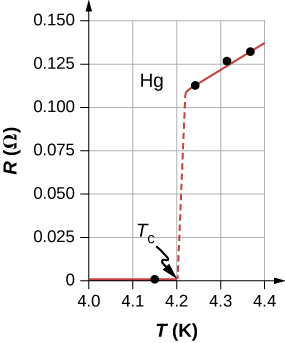
Other Superconducting Materials
As research continued, several other materials were found to enter a superconducting phase, when the temperature reached near absolute zero. In 1941, an alloy of niobium-nitride was found that could become superconducting at [latex]{T}_{\text{c}}=16\phantom{\rule{0.2em}{0ex}}\text{K}\left(-257\phantom{\rule{0.2em}{0ex}}\text{°}\text{C}\right)[/latex] and in 1953, vanadium-silicon was found to become superconductive at [latex]{T}_{\text{c}}=17.5\phantom{\rule{0.2em}{0ex}}\text{K}\left(-255.7\phantom{\rule{0.2em}{0ex}}\text{°}\text{C}\right).[/latex] The temperatures for the transition into superconductivity were slowly creeping higher. Strangely, many materials that make good conductors, such as copper, silver, and gold, do not exhibit superconductivity. Imagine the energy savings if transmission lines for electric power-generating stations could be made to be superconducting at temperatures near room temperature! A resistance of zero ohms means no [latex]{I}^{2}R[/latex] losses and a great boost to reducing energy consumption. The problem is that [latex]{T}_{\text{c}}=17.5\phantom{\rule{0.2em}{0ex}}\text{K}[/latex] is still very cold and in the range of liquid helium temperatures. At this temperature, it is not cost effective to transmit electrical energy because of the cooling requirements.
A large jump was seen in 1986, when a team of researchers, headed by Dr. Ching Wu Chu of Houston University, fabricated a brittle, ceramic compound with a transition temperature of [latex]{T}_{\text{c}}=92\phantom{\rule{0.2em}{0ex}}\text{K}\left(-181\phantom{\rule{0.2em}{0ex}}\text{°}\text{C}\right)[/latex]. The ceramic material, composed of yttrium barium copper oxide (YBCO), was an insulator at room temperature. Although this temperature still seems quite cold, it is near the boiling point of liquid nitrogen, a liquid commonly used in refrigeration. You may have noticed refrigerated trucks traveling down the highway labeled as “Liquid Nitrogen Cooled.”
YBCO ceramic is a material that could be useful for transmitting electrical energy because the cost saving of reducing the [latex]{I}^{2}R[/latex] losses are larger than the cost of cooling the superconducting cable, making it financially feasible. There were and are many engineering problems to overcome. For example, unlike traditional electrical cables, which are flexible and have a decent tensile strength, ceramics are brittle and would break rather than stretch under pressure. Processes that are rather simple with traditional cables, such as making connections, become difficult when working with ceramics. The problems are difficult and complex, and material scientists and engineers are coming up with innovative solutions.
An interesting consequence of the resistance going to zero is that once a current is established in a superconductor, it persists without an applied voltage source. Current loops in a superconductor have been set up and the current loops have been observed to persist for years without decaying.
Zero resistance is not the only interesting phenomenon that occurs as the materials reach their transition temperatures. A second effect is the exclusion of magnetic fields. This is known as the Meissner effect (Figure 9.28). A light, permanent magnet placed over a superconducting sample will levitate in a stable position above the superconductor. High-speed trains have been developed that levitate on strong superconducting magnets, eliminating the friction normally experienced between the train and the tracks. In Japan, the Yamanashi Maglev test line opened on April 3, 1997. In April 2015, the MLX01 test vehicle attained a speed of 374 mph (603 km/h).
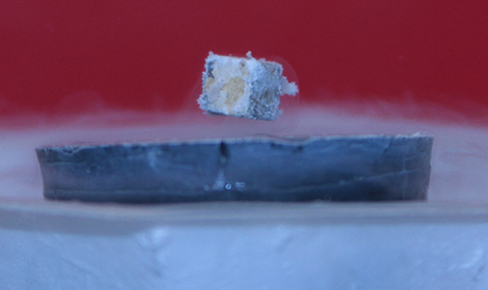
Table 9.3 shows a select list of elements, compounds, and high-temperature superconductors, along with the critical temperatures for which they become superconducting. Each section is sorted from the highest critical temperature to the lowest. Also listed is the critical magnetic field for some of the materials. This is the strength of the magnetic field that destroys superconductivity. Finally, the type of the superconductor is listed.
There are two types of superconductors. There are 30 pure metals that exhibit zero resistivity below their critical temperature and exhibit the Meissner effect, the property of excluding magnetic fields from the interior of the superconductor while the superconductor is at a temperature below the critical temperature. These metals are called Type I superconductors. The superconductivity exists only below their critical temperatures and below a critical magnetic field strength. Type I superconductors are well described by the BCS theory (described next). Type I superconductors have limited practical applications because the strength of the critical magnetic field needed to destroy the superconductivity is quite low.
Type II superconductors are found to have much higher critical magnetic fields and therefore can carry much higher current densities while remaining in the superconducting state. A collection of various ceramics containing barium-copper-oxide have much higher critical temperatures for the transition into a superconducting state. Superconducting materials that belong to this subcategory of the Type II superconductors are often categorized as high-temperature superconductors.
Introduction to BCS Theory
Type I superconductors, along with some Type II superconductors can be modeled using the BCS theory, proposed by John Bardeen, Leon Cooper, and Robert Schrieffer. Although the theory is beyond the scope of this chapter, a short summary of the theory is provided here. (More detail is provided in Condensed Matter Physics.) The theory considers pairs of electrons and how they are coupled together through lattice-vibration interactions. Through the interactions with the crystalline lattice, electrons near the Fermi energy level feel a small attractive force and form pairs (Cooper pairs), and the coupling is known as a phonon interaction. Single electrons are fermions, which are particles that obey the Pauli exclusion principle. The Pauli exclusion principle in quantum mechanics states that two identical fermions (particles with half-integer spin) cannot occupy the same quantum state simultaneously. Each electron has four quantum numbers [latex]\left(n,l,{m}_{l},{m}_{s}\right)[/latex]. The principal quantum number (n) describes the energy of the electron, the orbital angular momentum quantum number (l) indicates the most probable distance from the nucleus, the magnetic quantum number [latex]\left({m}_{l}\right)[/latex] describes the energy levels in the subshell, and the electron spin quantum number [latex]\left({m}_{s}\right)[/latex] describes the orientation of the spin of the electron, either up or down. As the material enters a superconducting state, pairs of electrons act more like bosons, which can condense into the same energy level and need not obey the Pauli exclusion principle. The electron pairs have a slightly lower energy and leave an energy gap above them on the order of 0.001 eV. This energy gap inhibits collision interactions that lead to ordinary resistivity. When the material is below the critical temperature, the thermal energy is less than the band gap and the material exhibits zero resistivity.
| Material | Symbol or Formula | Critical Temperature Tc (K) |
Critical Magnetic Field Hc (T) |
Type |
|---|---|---|---|---|
| Elements | ||||
| Lead | Pb | 7.19 | 0.08 | I |
| Lanthanum | La | ([latex]\alpha[/latex]) 4.90 − ([latex]\beta[/latex]) 6.30 | I | |
| Tantalum | Ta | 4.48 | 0.09 | I |
| Mercury | Hg | ([latex]\alpha[/latex]) 4.15 − ([latex]\beta[/latex]) 3.95 | 0.04 | I |
| Tin | Sn | 3.72 | 0.03 | I |
| Indium | In | 3.40 | 0.03 | I |
| Thallium | Tl | 2.39 | 0.03 | I |
| Rhenium | Re | 2.40 | 0.03 | I |
| Thorium | Th | 1.37 | 0.013 | I |
| Protactinium | Pa | 1.40 | I | |
| Aluminum | Al | 1.20 | 0.01 | I |
| Gallium | Ga | 1.10 | 0.005 | I |
| Zinc | Zn | 0.86 | 0.014 | I |
| Titanium | Ti | 0.39 | 0.01 | I |
| Uranium | U | ([latex]\alpha[/latex]) 0.68 − ([latex]\beta[/latex]) 1.80 | I | |
| Cadmium | Cd | 11.4 | 4.00 | I |
| Compounds | ||||
| Niobium-germanium | Nb3Ge | 23.20 | 37.00 | II |
| Niobium-tin | Nb3Sn | 18.30 | 30.00 | II |
| Niobium-nitrite | NbN | 16.00 | II | |
| Niobium-titanium | NbTi | 10.00 | 15.00 | II |
| High-Temperature Oxides | ||||
| HgBa2CaCu2O8 | 134.00 | II | ||
| Tl2Ba2Ca2Cu3O10 | 125.00 | II | ||
| YBa2Cu3O7 | 92.00 | 120.00 | II | |
Applications of Superconductors
Superconductors can be used to make superconducting magnets. These magnets are 10 times stronger than the strongest electromagnets. These magnets are currently in use in magnetic resonance imaging (MRI), which produces high-quality images of the body interior without dangerous radiation.
Another interesting application of superconductivity is the SQUID (superconducting quantum interference device). A SQUID is a very sensitive magnetometer used to measure extremely subtle magnetic fields. The operation of the SQUID is based on superconducting loops containing Josephson junctions. A Josephson junction is the result of a theoretical prediction made by B. D. Josephson in an article published in 1962. In the article, Josephson described how a supercurrent can flow between two pieces of superconductor separated by a thin layer of insulator. This phenomenon is now called the Josephson effect. The SQUID consists of a superconducting current loop containing two Josephson junctions, as shown in Figure 9.29. When the loop is placed in even a very weak magnetic field, there is an interference effect that depends on the strength of the magnetic field.
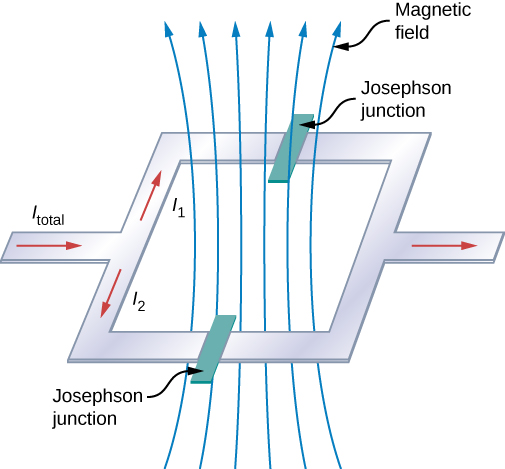
Superconductivity is a fascinating and useful phenomenon. At critical temperatures near the boiling point of liquid nitrogen, superconductivity has special applications in MRIs, particle accelerators, and high-speed trains. Will we reach a state where we can have materials enter the superconducting phase at near room temperatures? It seems a long way off, but if scientists in 1911 were asked if we would reach liquid-nitrogen temperatures with a ceramic, they might have thought it implausible.
Summary
- Superconductivity is a phenomenon that occurs in some materials when cooled to very low critical temperatures, resulting in a resistance of exactly zero and the expulsion of all magnetic fields.
- Materials that are normally good conductors (such as copper, gold, and silver) do not experience superconductivity.
- Superconductivity was first observed in mercury by Heike Kamerlingh Onnes in 1911. In 1986, Dr. Ching Wu Chu of Houston University fabricated a brittle, ceramic compound with a critical temperature close to the temperature of liquid nitrogen.
- Superconductivity can be used in the manufacture of superconducting magnets for use in MRIs and high-speed, levitated trains.
Key Equations
| Average electrical current | [latex]{I}_{\text{ave}}=\frac{\text{Δ}Q}{\text{Δ}t}[/latex] |
| Definition of an ampere | [latex]1\phantom{\rule{0.2em}{0ex}}\text{A}=1\phantom{\rule{0.2em}{0ex}}\text{C/s}[/latex] |
| Electrical current | [latex]I=\frac{dQ}{dt}[/latex] |
| Drift velocity | [latex]{v}_{d}=\frac{I}{nqA}[/latex] |
| Current density | [latex]I=\underset{\text{area}}{\iint }\stackrel{\to }{\textbf{J}}·d\stackrel{\to }{\textbf{A}}[/latex] |
| Resistivity | [latex]\rho =\frac{E}{J}[/latex] |
| Common expression of Ohm’s law | [latex]V=IR[/latex] |
| Resistivity as a function of temperature | [latex]\rho ={\rho }_{0}\left[1+\alpha \left(T-{T}_{0}\right)\right][/latex] |
| Definition of resistance | [latex]R\equiv \frac{V}{I}[/latex] |
| Resistance of a cylinder of material | [latex]R=\rho \frac{L}{A}[/latex] |
| Temperature dependence of resistance | [latex]R={R}_{0}\left(1+\alpha \text{Δ}T\right)[/latex] |
| Electric power | [latex]P=IV[/latex] |
| Power dissipated by a resistor | [latex]P={I}^{2}R=\frac{{V}^{2}}{R}[/latex] |
Conceptual Questions
What requirement for superconductivity makes current superconducting devices expensive to operate?
Show Solution
Very low temperatures necessitate refrigeration. Some materials require liquid nitrogen to cool them below their critical temperatures. Other materials may need liquid helium, which is even more costly.
Name two applications for superconductivity listed in this section and explain how superconductivity is used in the application. Can you think of a use for superconductivity that is not listed?
Problems
Consider a power plant is located 60 km away from a residential area uses 0-gauge [latex]\left(A=42.40\phantom{\rule{0.2em}{0ex}}{\text{mm}}^{2}\right)[/latex] wire of copper to transmit power at a current of [latex]I=100.00\phantom{\rule{0.2em}{0ex}}\text{A}[/latex]. How much more power is dissipated in the copper wires than it would be in superconducting wires?
Show Solution
[latex]\begin{array}{}\\ \\ \\ \\ {R}_{\text{copper}}=23.77\phantom{\rule{0.2em}{0ex}}\text{Ω}\phantom{\rule{0.2em}{0ex}}\hfill \\ P=2.377\phantom{\rule{0.2em}{0ex}}×\phantom{\rule{0.2em}{0ex}}{10}^{5}\text{W}\hfill \end{array}[/latex]
A wire is drawn through a die, stretching it to four times its original length. By what factor does its resistance increase?
Digital medical thermometers determine temperature by measuring the resistance of a semiconductor device called a thermistor (which has [latex]\alpha =-0.06\text{/}\text{°}\text{C}[/latex]) when it is at the same temperature as the patient. What is a patient’s temperature if the thermistor’s resistance at that temperature is 82.0% of its value at [latex]37\phantom{\rule{0.2em}{0ex}}\text{°}\text{C}[/latex] (normal body temperature)?
Show Solution
[latex]\begin{array}{c}R={R}_{0}\left(1+\alpha \left(T-{T}_{0}\right)\right)\hfill \\ 0.82{R}_{0}={R}_{0}\left(1+\alpha \left(T-{T}_{0}\right)\right),\phantom{\rule{0.8em}{0ex}}0.82=1-0.06\left(T-37\phantom{\rule{0.2em}{0ex}}\text{°}\text{C}\right),\phantom{\rule{0.8em}{0ex}}T=40\phantom{\rule{0.2em}{0ex}}\text{°}\text{C}\hfill \end{array}[/latex]
Electrical power generators are sometimes “load tested” by passing current through a large vat of water. A similar method can be used to test the heat output of a resistor. A [latex]R=30\phantom{\rule{0.2em}{0ex}}\text{Ω}[/latex] resistor is connected to a 9.0-V battery and the resistor leads are waterproofed and the resistor is placed in 1.0 kg of room temperature water [latex]\left(T=20\phantom{\rule{0.2em}{0ex}}\text{°}\text{C}\right)[/latex]. Current runs through the resistor for 20 minutes. Assuming all the electrical energy dissipated by the resistor is converted to heat, what is the final temperature of the water?
A 12-gauge gold wire has a length of 1 meter. (a) What would be the length of a silver 12-gauge wire with the same resistance? (b) What are their respective resistances at the temperature of boiling water?
Show Solution
a. [latex]{R}_{\text{Au}}={R}_{\text{Ag}},\phantom{\rule{0.8em}{0ex}}{\rho }_{\text{Au}}\frac{{L}_{\text{Au}}}{{A}_{\text{Au}}}={\rho }_{\text{Ag}}\frac{{L}_{\text{Ag}}}{{A}_{\text{Ag}}},\phantom{\rule{0.8em}{0ex}}{L}_{\text{Ag}}=1.53\phantom{\rule{0.2em}{0ex}}\text{m}[/latex];
b. [latex]{R}_{\text{Au,20 °C}}=0.0074\phantom{\rule{0.2em}{0ex}}\text{Ω}\phantom{\rule{0.2em}{0ex}},\phantom{\rule{0.8em}{0ex}}{R}_{\text{Au,100 °C}}=0.0094\phantom{\rule{0.2em}{0ex}}\text{Ω}\phantom{\rule{0.2em}{0ex}},\phantom{\rule{0.8em}{0ex}}{R}_{\text{Ag},100\phantom{\rule{0.2em}{0ex}}\text{°C}}=0.0096\phantom{\rule{0.2em}{0ex}}\text{Ω}[/latex]
What is the change in temperature required to decrease the resistance for a carbon resistor by 10%?
Additional Problems
A coaxial cable consists of an inner conductor with radius [latex]{r}_{\text{i}}=0.25\phantom{\rule{0.2em}{0ex}}\text{cm}[/latex] and an outer radius of [latex]{r}_{\text{o}}=0.5\phantom{\rule{0.2em}{0ex}}\text{cm}[/latex] and has a length of 10 meters. Plastic, with a resistivity of [latex]\rho =2.00\phantom{\rule{0.2em}{0ex}}×\phantom{\rule{0.2em}{0ex}}{10}^{13}\phantom{\rule{0.2em}{0ex}}\text{Ω}\phantom{\rule{0.2em}{0ex}}·\text{m}[/latex], separates the two conductors. What is the resistance of the cable?
Show Solution
[latex]\begin{array}{ccc}\hfill dR& =\hfill & \frac{\rho }{2\pi rL}dr\hfill \\ \hfill R& =\hfill & \frac{\rho }{2\pi L}\text{ln}\phantom{\rule{0.2em}{0ex}}\frac{{r}_{\text{o}}}{{r}_{\text{i}}}\hfill \\ \hfill R& =\hfill & 2.21\phantom{\rule{0.2em}{0ex}}×\phantom{\rule{0.2em}{0ex}}{10}^{11}\phantom{\rule{0.2em}{0ex}}\text{Ω}\phantom{\rule{0.2em}{0ex}}\hfill \end{array}[/latex]
A 10.00-meter long wire cable that is made of copper has a resistance of 0.051 ohms. (a) What is the weight if the wire was made of copper? (b) What is the weight of a 10.00-meter-long wire of the same gauge made of aluminum? (c)What is the resistance of the aluminum wire? The density of copper is [latex]8960{\phantom{\rule{0.2em}{0ex}}\text{kg/m}}^{3}[/latex] and the density of aluminum is [latex]2760{\phantom{\rule{0.2em}{0ex}}\text{kg/m}}^{3}[/latex].
A nichrome rod that is 3.00 mm long with a cross-sectional area of [latex]1.00{\phantom{\rule{0.2em}{0ex}}\text{mm}}^{2}[/latex] is used for a digital thermometer. (a) What is the resistance at room temperature? (b) What is the resistance at body temperature?
Show Solution
a.
[latex]{R}_{0}=0.003\phantom{\rule{0.2em}{0ex}}\text{Ω}[/latex]; b.
[latex]\begin{array}{ccc}\hfill {T}_{\text{c}}& =\hfill & 37.0\phantom{\rule{0.2em}{0ex}}\text{°}\text{C}\hfill \\ \hfill R& =\hfill & 0.00302\phantom{\rule{0.2em}{0ex}}\text{Ω}\phantom{\rule{0.2em}{0ex}}\hfill \end{array}[/latex]
The temperature in Philadelphia, PA can vary between [latex]68.00\phantom{\rule{0.2em}{0ex}}\text{°}\text{F}[/latex] and [latex]100.00\phantom{\rule{0.2em}{0ex}}\text{°}\text{F}[/latex] in one summer day. By what percentage will an aluminum wire’s resistance change during the day?
When 100.0 V is applied across a 5-gauge (diameter 4.621 mm) wire that is 10 m long, the magnitude of the current density is [latex]2.0\phantom{\rule{0.2em}{0ex}}×\phantom{\rule{0.2em}{0ex}}{10}^{8}{\text{A/m}}^{2}[/latex]. What is the resistivity of the wire?
Show Solution
[latex]\rho =5.00\phantom{\rule{0.2em}{0ex}}×\phantom{\rule{0.2em}{0ex}}{10}^{-8}\phantom{\rule{0.2em}{0ex}}\text{Ω}\phantom{\rule{0.2em}{0ex}}·\text{m}[/latex]
A wire with a resistance of [latex]5.0\phantom{\rule{0.2em}{0ex}}\text{Ω}[/latex] is drawn out through a die so that its new length is twice times its original length. Find the resistance of the longer wire. You may assume that the resistivity and density of the material are unchanged.
What is the resistivity of a wire of 5-gauge wire ([latex]A=16.8\phantom{\rule{0.2em}{0ex}}×\phantom{\rule{0.2em}{0ex}}{10}^{-6}{\text{m}}^{2}[/latex]), 5.00 m length, and [latex]5.10\phantom{\rule{0.2em}{0ex}}\text{m}\phantom{\rule{0.2em}{0ex}}\text{Ω}[/latex] resistance?
Show Solution
[latex]\rho =1.71\phantom{\rule{0.2em}{0ex}}×\phantom{\rule{0.2em}{0ex}}{10}^{-8}\phantom{\rule{0.2em}{0ex}}\text{Ω}\phantom{\rule{0.2em}{0ex}}·\text{m}[/latex]
Coils are often used in electrical and electronic circuits. Consider a coil which is formed by winding 1000 turns of insulated 20-gauge copper wire (area [latex]{0.52\phantom{\rule{0.2em}{0ex}}\text{mm}}^{2}[/latex]) in a single layer on a cylindrical non-conducting core of radius 2.0 mm. What is the resistance of the coil? Neglect the thickness of the insulation.
Currents of approximately 0.06 A can be potentially fatal. Currents in that range can make the heart fibrillate (beat in an uncontrolled manner). The resistance of a dry human body can be approximately [latex]100\phantom{\rule{0.2em}{0ex}}\text{k}\phantom{\rule{0.2em}{0ex}}\text{Ω}[/latex]. (a) What voltage can cause 0.06 A through a dry human body? (b) When a human body is wet, the resistance can fall to [latex]100\phantom{\rule{0.2em}{0ex}}\text{Ω}[/latex]. What voltage can cause harm to a wet body?
Show Solution
a. [latex]V=6000\phantom{\rule{0.2em}{0ex}}\text{V}[/latex]; b. [latex]V=6\phantom{\rule{0.2em}{0ex}}\text{V}[/latex]
A 20.00-ohm, 5.00-watt resistor is placed in series with a power supply. (a) What is the maximum voltage that can be applied to the resistor without harming the resistor? (b) What would be the current through the resistor?
A battery with an emf of 24.00 V delivers a constant current of 2.00 mA to an appliance. How much work does the battery do in three minutes?
Show Solution
[latex]P=\frac{W}{t},\phantom{\rule{0.8em}{0ex}}W=8.64\phantom{\rule{0.2em}{0ex}}\text{J}[/latex]
A 12.00-V battery has an internal resistance of a tenth of an ohm. (a) What is the current if the battery terminals are momentarily shorted together? (b) What is the terminal voltage if the battery delivers 0.25 amps to a circuit?
Challenge Problems
A 10-gauge copper wire has a cross-sectional area [latex]A=5.26\phantom{\rule{0.2em}{0ex}}{\text{mm}}^{2}[/latex] and carries a current of [latex]I=5.00\phantom{\rule{0.2em}{0ex}}\text{A}[/latex]. The density of copper is [latex]\rho =8.95{\phantom{\rule{0.2em}{0ex}}\text{g/cm}}^{3}[/latex]. One mole of copper atoms [latex]\left(6.02\phantom{\rule{0.2em}{0ex}}×\phantom{\rule{0.2em}{0ex}}{10}^{23}\text{atoms}\right)[/latex] has a mass of approximately 63.50 g. What is the magnitude of the drift velocity of the electrons, assuming that each copper atom contributes one free electron to the current?
Show Solution
[latex]\begin{array}{}\\ \\ V=7.09\phantom{\rule{0.2em}{0ex}}{\text{cm}}^{3}\hfill \\ n=8.49\phantom{\rule{0.2em}{0ex}}×\phantom{\rule{0.2em}{0ex}}{10}^{28}\frac{\text{electrons}}{{\text{m}}^{3}}\hfill \\ {v}_{\text{d}}=7.00\phantom{\rule{0.2em}{0ex}}×\phantom{\rule{0.2em}{0ex}}{10}^{-5}\frac{\text{m}}{\text{s}}\hfill \end{array}[/latex]
The current through a 12-gauge wire is given as [latex]I\left(t\right)=\left(5.00\phantom{\rule{0.2em}{0ex}}\text{A}\right)\phantom{\rule{0.2em}{0ex}}\text{sin}\phantom{\rule{0.2em}{0ex}}\left(2\pi 60\phantom{\rule{0.2em}{0ex}}\text{Hz}\phantom{\rule{0.2em}{0ex}}t\right)[/latex]. What is the current density at time 15.00 ms?
A particle accelerator produces a beam with a radius of 1.25 mm with a current of 2.00 mA. Each proton has a kinetic energy of 10.00 MeV. (a) What is the velocity of the protons? (b) What is the number (n) of protons per unit volume? (b) How many electrons pass a cross sectional area each second?
Show Solution
a. 4.38 x 107 m/s b. [latex]v=5.81\phantom{\rule{0.2em}{0ex}}×\phantom{\rule{0.2em}{0ex}}{10}^{13}\phantom{\rule{0.2em}{0ex}}\frac{\text{protons}}{{\text{m}}^{3}}[/latex] c. [latex]1.25\phantom{\rule{0.2em}{0ex}}\frac{\text{electrons}}{{\text{m}}^{3}}[/latex]
In this chapter, most examples and problems involved direct current (DC). DC circuits have the current flowing in one direction, from positive to negative. When the current was changing, it was changed linearly from [latex]I=\text{−}{I}_{\text{max}}[/latex] to [latex]I=+{I}_{\text{max}}[/latex] and the voltage changed linearly from [latex]V=\text{−}{V}_{\text{max}}[/latex] to [latex]V=+{V}_{\text{max}}[/latex], where [latex]{V}_{\text{max}}={I}_{\text{max}}R[/latex]. Suppose a voltage source is placed in series with a resistor of [latex]R=10\phantom{\rule{0.2em}{0ex}}\text{Ω}[/latex] that supplied a current that alternated as a sine wave, for example, [latex]I\left(t\right)=\left(3.00\phantom{\rule{0.2em}{0ex}}\text{A}\right)\phantom{\rule{0.2em}{0ex}}\text{sin}\phantom{\rule{0.2em}{0ex}}\left(\frac{2\pi }{4.00\phantom{\rule{0.2em}{0ex}}\text{s}}t\right)[/latex]. (a) What would a graph of the voltage drop across the resistor V(t) versus time look like? (b) What would a plot of V(t) versus I(t) for one period look like? (Hint: If you are not sure, try plotting V(t) versus I(t) using a spreadsheet.)
A current of [latex]I=25A[/latex] is drawn from a 100-V battery for 30 seconds. By how much is the chemical energy reduced?
Show Solution
[latex]E=75\phantom{\rule{0.2em}{0ex}}\text{kJ}[/latex]
Consider a square rod of material with sides of length [latex]L=3.00\phantom{\rule{0.2em}{0ex}}\text{cm}[/latex] with a current density of [latex]\stackrel{\to }{\textbf{J}}={J}_{0}{e}^{\alpha x}\hat{\textbf{k}}=\left(0.35\frac{\text{A}}{{\text{m}}^{2}}\right){e}^{\left(2.1\phantom{\rule{0.2em}{0ex}}×\phantom{\rule{0.2em}{0ex}}{10}^{-3}{\text{m}}^{-1}\right)x}\hat{\textbf{k}}[/latex] as shown below. Find the current that passes through the face of the rod.
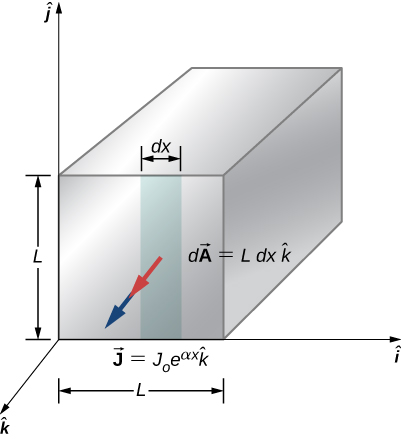
A resistor of an unknown resistance is placed in an insulated container filled with 0.75 kg of water. A voltage source is connected in series with the resistor and a current of 1.2 amps flows through the resistor for 10 minutes. During this time, the temperature of the water is measured and the temperature change during this time is [latex]\text{Δ}T=10.00\phantom{\rule{0.2em}{0ex}}\text{°}\text{C}[/latex]. (a) What is the resistance of the resistor? (b) What is the voltage supplied by the power supply?
Show Solution
a. [latex]\begin{array}{}\\ \\ \\ P=52\phantom{\rule{0.2em}{0ex}}\text{W}\hfill \\ R=36\phantom{\rule{0.2em}{0ex}}\text{Ω}\phantom{\rule{0.2em}{0ex}}\hfill \end{array}[/latex]; b. [latex]V=43.54\phantom{\rule{0.2em}{0ex}}\text{V}[/latex]
The charge that flows through a point in a wire as a function of time is modeled as [latex]q\left(t\right)={q}_{0}{e}^{\text{−}t\text{/}T}=10.0\phantom{\rule{0.2em}{0ex}}\text{C}{e}^{\text{−}t\text{/}5\phantom{\rule{0.2em}{0ex}}\text{s}}[/latex]. (a) What is the initial current through the wire at time [latex]t=0.00\phantom{\rule{0.2em}{0ex}}\text{s}[/latex]? (b) Find the current at time [latex]t=\frac{1}{2}T[/latex]. (c) At what time t will the current be reduced by one-half [latex]I=\frac{1}{2}{I}_{0}[/latex]?
Consider a resistor made from a hollow cylinder of carbon as shown below. The inner radius of the cylinder is [latex]{R}_{i}=0.20\phantom{\rule{0.2em}{0ex}}\text{mm}[/latex] and the outer radius is [latex]{R}_{0}=0.30\phantom{\rule{0.2em}{0ex}}\text{mm}[/latex]. The length of the resistor is [latex]L=0.90\phantom{\rule{0.2em}{0ex}}\text{mm}[/latex]. The resistivity of the carbon is [latex]\rho =3.5\phantom{\rule{0.2em}{0ex}}×\phantom{\rule{0.2em}{0ex}}{10}^{-5}\phantom{\rule{0.2em}{0ex}}\text{Ω}\phantom{\rule{0.2em}{0ex}}·\text{m}[/latex]. (a) Prove that the resistance perpendicular from the axis is [latex]R=\frac{\rho }{2\pi L}\text{ln}\left(\frac{{R}_{0}}{{R}_{i}}\right).[/latex] (b) What is the resistance?
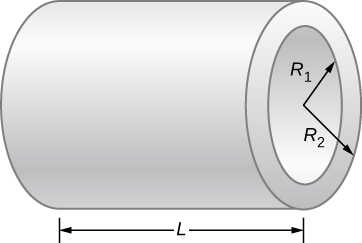
Show Solution
a. [latex]R=\frac{\rho }{2\pi L}\text{ln}\left(\frac{{R}_{0}}{{R}_{i}}\right)[/latex]; b. [latex]R=2.5\phantom{\rule{0.2em}{0ex}}\text{m}\phantom{\rule{0.2em}{0ex}}\text{Ω}[/latex]
What is the current through a cylindrical wire of radius [latex]R=0.1\phantom{\rule{0.2em}{0ex}}\text{mm}[/latex] if the current density is [latex]J=\frac{{J}_{0}}{R}r[/latex], where [latex]{J}_{0}=32000\frac{\text{A}}{{\text{m}}^{2}}?[/latex]
A student uses a 100.00-W, 115.00-V radiant heater to heat the student’s dorm room, during the hours between sunset and sunrise, 6:00 p.m. to 7:00 a.m. (a) What current does the heater operate at? (b) How many electrons move through the heater? (c) What is the resistance of the heater? (d) How much heat was added to the dorm room?
Show Solution
(a) 0.870 A
(b) #electrons = 2.54 × 1023 electrons
(c) 132 ohms
(d) q = 4.68 × 106 J
A 12-V car battery is used to power a 20.00-W, 12.00-V lamp during the physics club camping trip/star party. The cable to the lamp is 2.00 meters long, 14-gauge copper wire with a charge density of [latex]n=9.50\phantom{\rule{0.2em}{0ex}}×\phantom{\rule{0.2em}{0ex}}{10}^{28}{\text{m}}^{-3}[/latex]. (a) What is the current draw by the lamp? (b) How long would it take an electron to get from the battery to the lamp?
A physics student uses a 115.00-V immersion heater to heat 400.00 grams (almost two cups) of water for herbal tea. During the two minutes it takes the water to heat, the physics student becomes bored and decides to figure out the resistance of the heater. The student starts with the assumption that the water is initially at the temperature of the room [latex]{T}_{i}=25.00\phantom{\rule{0.2em}{0ex}}\text{°}\text{C}[/latex] and reaches [latex]{T}_{f}=100.00\phantom{\rule{0.2em}{0ex}}\text{°}\text{C}[/latex]. The specific heat of the water is [latex]c=4180\frac{\text{J}}{\text{kg∙K}}[/latex]. What is the resistance of the heater?
Show Solution
[latex]P=1045\phantom{\rule{0.2em}{0ex}}\text{W},\phantom{\rule{0.8em}{0ex}}P=\frac{{V}^{2}}{R},\phantom{\rule{0.8em}{0ex}}R=12.27\phantom{\rule{0.2em}{0ex}}\text{Ω}[/latex]
Glossary
- critical temperature
- temperature at which a material reaches superconductivity
- Josephson junction
- junction of two pieces of superconducting material separated by a thin layer of insulating material, which can carry a supercurrent
- Meissner effect
- phenomenon that occurs in a superconducting material where all magnetic fields are expelled
- SQUID
- (Superconducting Quantum Interference Device) device that is a very sensitive magnetometer, used to measure extremely subtle magnetic fields
- superconductivity
- phenomenon that occurs in some materials where the resistance goes to exactly zero and all magnetic fields are expelled, which occurs dramatically at some low critical temperature [latex]\left({T}_{C}\right)[/latex]
Licenses and Attributions
Superconductors. Authored by: OpenStax College. Located at: https://openstax.org/books/university-physics-volume-2/pages/9-6-superconductors. License: CC BY: Attribution. License Terms: Download for free at https://openstax.org/books/university-physics-volume-2/pages/1-introduction

